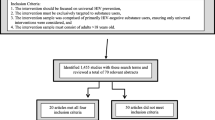Abstract
Using cross-sectional data from an ethnically diverse sample of 161 HIV-seropositive injection drug users (IDUs), we investigated (1) how HIV-positive IDUs rank their life priorities, (2) whether HIV prioritization (defined as whether or not ranking HIV as a top priority) is associated with risk behaviors, and (3) potential correlates of HIV prioritization. HIV was ranked as the most important priority by 37% of the participants. Among those who did not rank HIV as the top priority, housing, money, and safety from violence were particularly salient priorities. Those who gave the highest priority to HIV were less likely to have unprotected vaginal sex with primary partners who were HIV negative or of unknown serostatus, were less likely to split drugs with a used syringe, and used fewer numbers of injection drugs. HIV prioritization, however, was not associated with sex risk behaviors with nonprimary partners and HIV-positive primary partners. Significant correlates of HIV prioritization included age and the use of a heroin/stimulant mixture. These findings provide a number of important implications for HIV prevention intervention research for HIV-positive IDUs.
Similar content being viewed by others
References
Avants, S. K., Warburton, L. A., Hawkins, K. A., and Margolin, A. (2000). Continuation of high-risk behavior by HIV-positive drug users: Treatment implications. Journal of Substance Abuse Treatment, 19, 15–22.
Bailey, C. J., Wolitski, R. J., Gomez, C., Parsons, J., and Remien, R. (2001, August). Who's responsible for ensuring safer sex? A qualitative study among HIV-seropositive men of perceived responsibility for preventing the transmission of HIV. Paper presented at the 2001 National HIV Prevention Conference, Atlanta, Georgia.
Bourgois, P. (1998). The moral economies of homeless heroin addicts: Confronting ethnography, HIV risk, and everyday violence in San Francisco shooting encampments. Substance Use and Misuse, 33, 2323–2351.
Centers for Disease Control and Prevention. (1996). Continued sexual risk behavior among HIV-seropositive, drug-using men–Atlanta, Washington D.C., and San Juan, Puerto Rico, 1993. Morbidity and Mortality Weekly Report, 45, 151–152.
Centers for Disease Control and Prevention. (2001). HIV/AIDS Surveillance Report, 13(2), 14.
Crepaz, N., and Marks, G. (2002). Towards an understanding of sexual risk behavior in people living with HIV: A review of social, psychological, and medical findings. AIDS, 16, 135–149.
Cunningham, W. E., Andersen, R. M., Katz, M. H., Stein, M. D., Turner, B. J., Crystal, S., Zierler, S., Kuromiya, K., Morton, S., St. Clair, P., Bozzette, S. A., and Shapiro, M. F. (1999). The impact of competing subsistence needs and barriers to access to medical care for persons with human immunodeficiency virus receiving care in the United States. Medical Care, 37, 1270–1281.
Derogatis, L. R., and Spencer, P. M. (1982). The Brief Symptom Inventory (BSI): Administration, scoring, and procedure manual–1. Baltimore, MD: Wiley.
Des Jarlais, D. C., Marmor, M., Friedmann, P., Titus, S., Aviles, E., Deren, S., Torian, L., Glebatis, D., Murrill, C., Monterroso, E., and Friedman, S. R. (2000). HIV incidence among injection drug users in New York City, 1992–1997: Evidence for a declining epidemic. American Journal of Public Health, 90, 352–359.
Janssen, R. S., Holtgrave, D. R., Valdiserri, R. O., Shepherd, M. A., Gayle, H. D., and DeCock, K. M. (2001). The serostatus approach to fighting the HIV epidemic: Prevention strategies for infected individuals. American Journal of Public Health, 91, 1019–1024.
Klee, H. (1991). Homelessness among injection drug users: Implications for the spread of AIDS. Journal of Community and Applied Social Psychology, 1, 143–154.
Knowlton, A. R., Latkin, C. A., Chung, S., Hoover, D. R., Ensminger, M., and Celentano, D. D. (2000). HIV and depressive symptoms among urban injection drug users. AIDS and Behavior, 4, 353–360.
Kotranski, L., Semaan, S., Collier, K., Lauby, J., Halbert, J., and Feighan, K. (1998). Effectiveness of an HIV risk reduction counseling intervention for out-of-treatment drug users. AIDS Education and Prevention, 10, 19–33.
Kwiatkowski, C. F., and Booth, R. (1998). HIV-seropositive drug users and unprotected sex. AIDS and Behavior, 2, 151–160.
Mallory, C., and Stern, P. N. (2000). Awakening as a change process among women at risk for HIV who engage in survival sex. Qualitative Health Research, 10, 581–594.
Marks, G., Burris, S., and Peterman, T. A. (1999). Reducing sexual transmission of HIV from those who know they are infected: The need for personal and collective responsibility. AIDS, 13, 297–306.
Metsch, L. R., McCoy, C. B., Lai, S., and Miles, C. (1998). Continuing risk behaviors among HIV-seropositive chronic drug users in Miami, Florida. AIDS and Behavior, 2, 161–169.
Palepu, A., Strathdee, S. A., Hogg, R. S., Anis, A. H., Rae, S., Cornelisse, P. G. A., Patrick, D. M., O'Shaughnessy, M. V., and Schechter, M. T. (1999). The social determinants of emergency department and hospital use by injection drug users in Canada. Journal of Urban Health, 76, 409–418.
Rabkin, J. G., Johnson, J., Lin, S.-H., Lipsitz, J. D., Remien, R. H., Williams, J. B. W., and Gorman, J. M. (1997). Psychopathology in male and female HIV-positive and negative injecting drug users: Longitudinal course over 3 years. AIDS, 11, 507–515.
Sherman, S. G., and Latkin, C. A. (2001). Intimate relationship characteristics associated with condom use among drug users and their sex partners: A multilevel analysis. Drug and Alcohol Dependence, 64, 97–104.
Turner, C. F., Ku, L., Rogers, S. M., Lindberg, L. D., Pleck, J. H., and Sonenstein, F. L. (1998). Adolescent sexual behavior, drug use, and violence: Increased reporting with computer survey technology. Science, 280, 867–73.
Weller, S. C., and Romney, A. K. (1998). Systematic data collection Newbury Park, CA; Sage.
Author information
Authors and Affiliations
Consortia
Corresponding author
Rights and permissions
About this article
Cite this article
Mizuno, Y., Purcell, D., Borkowski, T.M. et al. The Life Priorities of HIV-Seropositive Injection Drug Users: Findings from a Community-Based Sample. AIDS Behav 7, 395–403 (2003). https://doi.org/10.1023/B:AIBE.0000004731.94734.77
Issue Date:
DOI: https://doi.org/10.1023/B:AIBE.0000004731.94734.77




